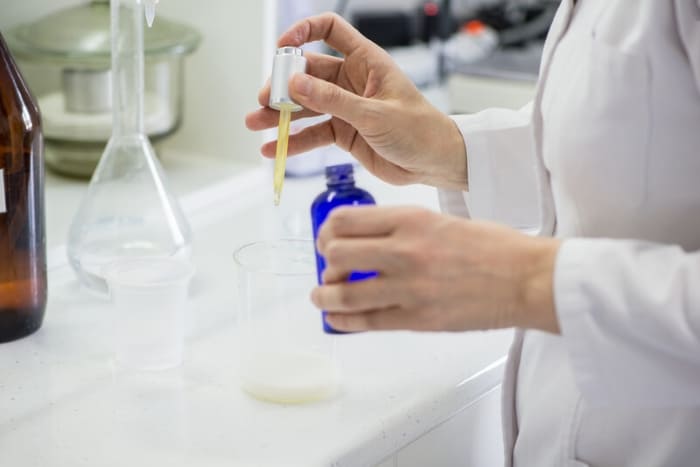A Man’s Beginner’s Guide to Scent, Perfume, and Fragrance

We may earn a commission for purchases using our links. Learn more
The art of smelling good can seem confusing – what is the difference between Cologne and Eau de Parfum? Here you learn everything you need to know about perfume fragrances!
What Exactly Is Perfume?
Perfume is the common name for all mixtures that primarily have a good smell. While some are applied directly to the skin, others are included as an ingredient in everything from soap to fabric softener. All perfumes consist of:
- Scent essence: Aromatic substances that set the scents themselves. Most are essential oils of plants.
- Binders: Substances that determine how quickly the perfume evaporates and the individual fragrances emerge.
- Solvents: Substances that keep the perfume liquid, often ethanol and/or water.
Humans have been making perfumes since ancient Mesopotamia. The word perfume is derived from the Latin perfumare, literally “to smoke through”, i.e. to smell. The first perfumes were relatively simple, essential oils from flowers and spices with low concentration.
Modern perfumes are most similar to those introduced in the late 1800s when synthetic aromas enabled sophisticated fragrance blends and new binders allowed longer durations.
Different Classes of Perfumes
Roughly speaking, there are 4 classes of perfumes, grouped according to the concentration of aromatic compounds:
- Perfume
- Eau de Parfum
- Eau de Toilette
- Cologne
A more concentrated perfume will, as a general rule, last longer and appear slower than a less concentrated variant, and this will be reflected in the price (provided that the fragrances themselves are equally exclusive). However, a higher concentration is not always better – many people may prefer low-concentration perfumes for a less intrusive good smell.
Since the modern perfume profession has its origins in France, the classes have French names. Different brands use the terms a little differently, so the concentrations are approximate values. Note: Perfume, also called “pure perfume”, is so strong that very few companies sell it to private individuals.
Eau de Parfum
12-20% fragrance essence. “Perfume water”: The strongest type you normally find for sale over the counter. Spray against the neck with a straight arm – this tends to last all day.
Recommended for: You who want the most exclusive and have nothing against prominent scent as long as it is comfortable.
Eau de Toilette
8-12% fragrance essence. Eau de Toilette is great for putting on a definite scent that is not disturbed by aftershave and other perfumed products. Be sparse in the application.
Recommended for: Those who want to let the same perfume gradually appear throughout the day instead of applying it several times.
Cologne
3-8% fragrance essence. “Everyday perfume”, supposedly originally from Cologne. Low concentration makes it unobtrusive. Often comes in larger bottles since you have to use more to give as much fragrance as Eau de Toilette. Nice to combine with deodorant, aftershave, and other fragrances.
Recommended for: Those who do not like the intrusive scent.
Fragrance Notes
Most perfumes consist of several different scents that are gradually expressed throughout the day. The art of making a good perfume consists of combining fragrances that go well together and composing binders and solvents so that the fragrances evaporate at different rates and pleasantly replace each other as the perfume is heated by the skin.
The odors are grouped in “notes” based on how quickly they appear after application. The same fragrance can be used for different notes, depending on when the perfumer wants the fragrance to be expressed.
Top Notes
The scents are felt immediately and form the first impression of the perfume. Top notes are often based on fresh and distinct scents, such as citrus/ orange, lavender, or pepper. In other words, when you try perfume, it is important to let it work for a while so that you do not only know the top notes. Lasts approx. 15 minutes.
Heart Notes
The odors appear immediately after the top notes have evaporated. As a rule, they are more subdued and gradually take some of the edges off the sharp top notes. Good heart notes are cinnamon, nutmeg, jasmine, lavender, and saffron. Together with the base notes, they form the basic stem of the perfume. Lasts approx. 1-2 hours.
Base Notes
These fragrances are bound up in the heaviest and most stable molecules in the perfume, which last the longest but are released the weakest. The base notes are thus the “deepest” and most subtle scents in the perfume. Sandalwood, cedar, vanilla, musk, and patchouli are sought-after base notes. As a rule, the base notes are not noticed until approx. 30 minutes have passed. Lasts up to 24 hours.
Good and Bad Perfume
The sense of smell is closely linked to our memory, so how a person smells immediately evokes vivid memories in us and subconsciously colors our impression of him or her. Good perfumes, therefore, smell not only pleasant but also distinctive. Exotic scents make it easier to speed up our ability to associate without drowning in the crowd, even if the perfume itself is subtle.
To get an exotic smell, you have to use exotic ingredients. Rare aromas that must be grown and distilled with care naturally result in a more exclusive perfume than more common fragrances that can be produced industrially. Composing the right fragrances together with the right binders for the fragrances to round and replace each other is also a demanding craft, which distinguishes “designer perfume” from generic products.
You notice this immediately when you try most perfumes produced on the license for large clothing brands – most smell the same and do not evoke for us other associations than cheap deodorant. A common trick is to use extremely hot top notes and weak binders so that the perfume gives an overwhelming first impression that quickly disappears completely.
Quality perfume, on the other hand, brings a fragrance you will not find anywhere else, and in some cases that you had no idea existed, that lasts all day and predictably changes character. British Laboratory Perfumes, as an example, has made sublime transitions that last around the clock, while Bon Parfumeur has a modular system where different perfumes can be combined to form your unique fragrance.
How to Use Perfume
Most perfumes come in bottles with a spray nozzle, which provides one dose of spray per pressure. Keep the nozzle at least 8″ (20 cm) away and give the nozzle a short, determined pressure. You do not have to push the nozzle down – it is a good idea to be restrictive with a new perfume before you get a sense of how concentrated it is. As a general rule, a little too little perfume is better than too much.
Testers usually do not have a spray nozzle – where you pull out a small strip as a roll-on deodorant or pat on a drop such as with an aftershave splash.
Don’t Rub
Friction heats the perfume too quickly so that the scents do not appear as they are intended.
Be Aware of the Weather
Hot weather makes the perfume evaporate faster. The perfume is more short-lived and intense than in cold weather.
Apply after Shower
Clean skin is the best canvas for a really good smell, and a shaved neck with a little moisturizer allows the perfume to appear perfect.
Select the Appropriate Size
A large, half-full bottle allows the perfume to come into contact with oxygen, which degrades even the best ingredients. Our perfumes come in bottles that match the concentration.
Avoid Crashes
Try using other products that do not collide with your perfume, especially if you use a weak type à la cologne. The scent from soap, shaving cream, or shaving soap and shower gel disappears quickly and is not usually a problem.
Be Sparse
Avoid soaking your whole body in perfume. Most men use a small dab on the neck, while women like to apply it on the wrists. Avoid applying it to your clothing.
